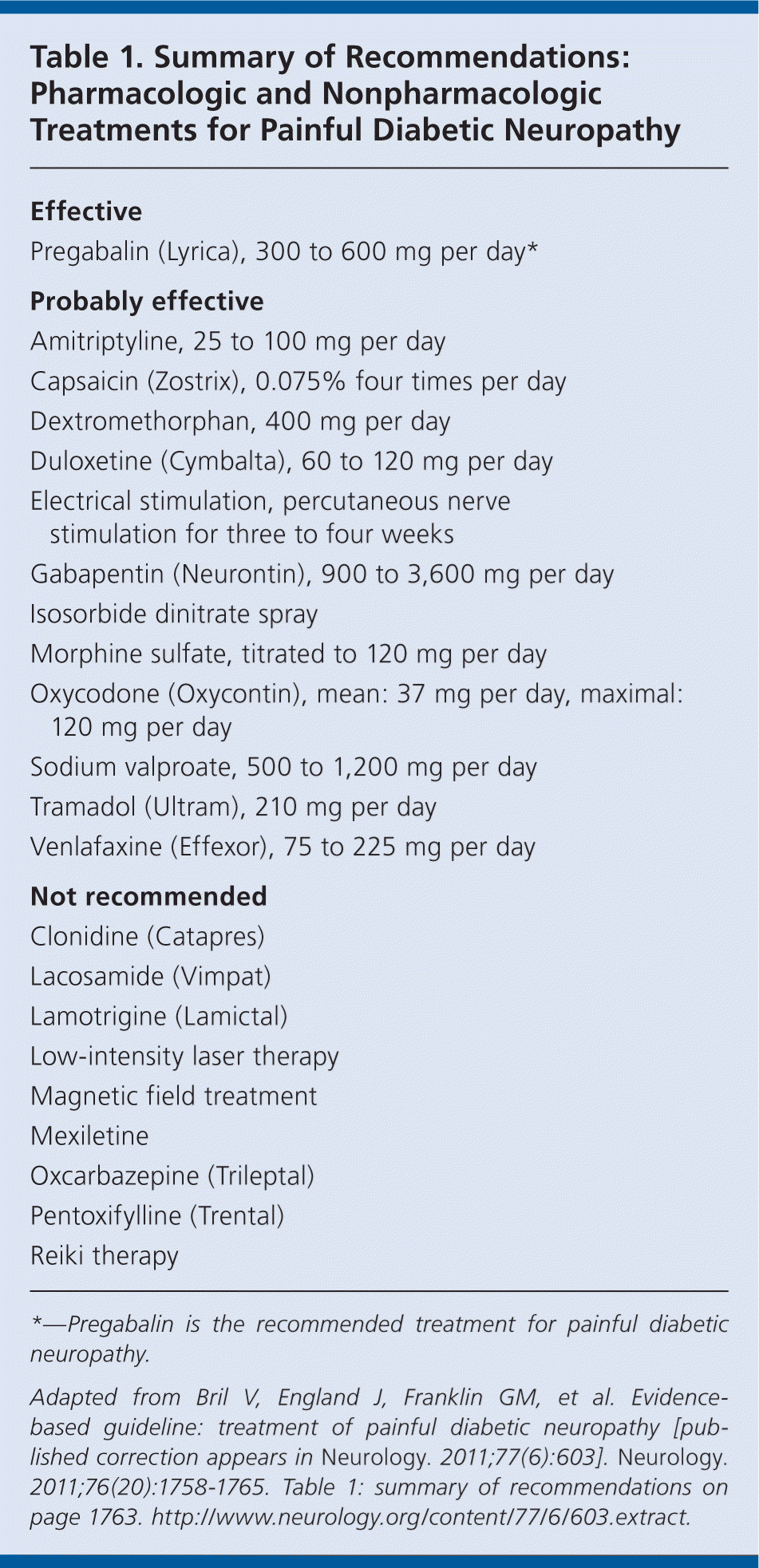
Am Fam Physician. 2012;86(5):469-470
Guideline source: American Academy of Neurology, American Association of Neuromuscular and Electrodiagnostic Medicine, American Academy of Physical Medicine and Rehabilitation
Evidence rating system used? Yes
Literature search described? Yes
Guideline developed by participants without relevant financial ties to industry? No
Published source: Neurology, May 2011
Available at: http://www.neurology.org/content/76/20/1758.full.html
Painful diabetic neuropathy is a chronic disease that affects approximately 16 percent of patients who have diabetes mellitus. About 16 percent of patients who have painful diabetic neuropathy do not report their symptoms to their physician, and 39 percent of patients with this condition do not receive treatment, creating an ongoing situation that can be challenging for patients, physicians, and caregivers.
The American Academy of Neurology (AAN), the American Association of Neuromuscular and Electrodiagnostic Medicine (AANEM), and the American Academy of Physical Medicine and Rehabilitation (AAPMR) have developed an evidence-based guideline for the treatment of painful diabetic neuropathy. The guideline is based on a systematic review of numerous pharmacologic and nonpharmacologic agents. It can be used by physicians to create a treatment plan that helps reduce pain and improve physical function and quality of life in patients who have this condition.
Pharmacologic Agents
Pregabalin (Lyrica), an anticonvulsant, is the only agent in the guideline that has been established as effective for the treatment of painful diabetic neuropathy and that should be offered if clinically appropriate. Pregabalin has been shown to reduce the pain associated with painful diabetic neuropathy, to improve patient quality of life, and to reduce interference with sleep (although the effect size is small).
The anticonvulsant medications gabapentin (Neurontin) and sodium valproate; the antidepressants amitriptyline, venlafaxine (Effexor), and duloxetine (Cymbalta); the opioids morphine sulfate, tramadol (Ultram), and controlled-release oxycodone (Oxycontin); and the antitussive dextromethorphan are probably effective in lessening pain, and should be considered for the treatment of painful diabetic neuropathy. Venlafaxine, duloxetine, and dextromethorphan also improve quality of life. In addition, venlafaxine may be added to gabapentin for a better response.
There is insufficient evidence to recommend for or against the use of the anticonvulsant topiramate (Topamax); the antidepressants desipramine (Norpramin), imipramine (Tofranil), and fluoxetine (Prozac); or the combination of nortriptyline (Pamelor) and fluphenazine.
The anticonvulsants oxcarbazepine (Trileptal), lamotrigine (Lamictal), and lacosamide (Vimpat) should probably not be considered.
The degree of pain relief provided by anticonvulsant medications has not been associated with improvements in physical function.
Sodium valproate is potentially teratogenic, and it should be avoided in women of childbearing age who have diabetes. In addition, sodium valproate is associated with adverse effects such as weight gain and a potential worsening of glycemic control. Because of these effects, it should not be considered the first treatment for painful diabetic neuropathy.
Tramadol and dextromethorphan are associated with considerable rates of adverse events such as sedation, nausea, and constipation. Use of opioid medications may also lead to the development of rebound headache and other novel pain syndromes; chronic use of opioids can lead to drug tolerance or dose escalation.
Alternative Pharmacologic Agents
Capsaicin cream (Zostrix) and isosorbide dinitrate spray are probably effective in reducing the pain associated with painful diabetic neuropathy, and should be considered for treatment. Although a number of clinical trials have shown that capsaicin is effective in reducing pain, many patients may be unable to tolerate the adverse effects, most notably a painful burning sensation on contact with warm or hot water, or in hot weather.
The lidocaine patch (Lidoderm) is possibly effective in reducing pain, and may be considered for treatment. There is insufficient evidence to recommend for or against the use of vitamins and alpha-lipoic acid.
Clonidine (Catapres), pentoxifylline (Trental), and mexiletine are probably not effective in the treatment of painful diabetic neuropathy, and should probably not be considered.
Nonpharmacologic Agents
Percutaneous electrical nerve stimulation is probably effective in reducing pain, and should be considered as treatment. There is some evidence that it may also improve sleep in patients who have painful diabetic neuropathy.
There is insufficient evidence to recommend for or against the use of amitriptyline plus electrotherapy. Other interventions, such as exercise and acupuncture, do not have any evidence of effectiveness in the treatment of painful diabetic neuropathy.
Electromagnetic field treatment (such as magnetized shoe insoles), low-intensity laser therapy, and Reiki therapy are probably not effective and should probably not be considered.
A summary of recommendations for the treatment of painful diabetic neuropathy is provided in Table 1.

| Effective |
| Pregabalin (Lyrica), 300 to 600 mg per day* |
| Probably effective |
| Amitriptyline, 25 to 100 mg per day |
| Capsaicin (Zostrix), 0.075% four times per day |
| Dextromethorphan, 400 mg per day |
| Duloxetine (Cymbalta), 60 to 120 mg per day |
| Electrical stimulation, percutaneous nerve stimulation for three to four weeks |
| Gabapentin (Neurontin), 900 to 3,600 mg per day |
| Isosorbide dinitrate spray |
| Morphine sulfate, titrated to 120 mg per day |
| Oxycodone (Oxycontin), mean: 37 mg per day, maximal: 120 mg per day |
| Sodium valproate, 500 to 1,200 mg per day |
| Tramadol (Ultram), 210 mg per day |
| Venlafaxine (Effexor), 75 to 225 mg per day |
| Not recommended |
| Clonidine (Catapres) |
| Lacosamide (Vimpat) |
| Lamotrigine (Lamictal) |
| Low-intensity laser therapy |
| Magnetic field treatment |
| Mexiletine |
| Oxcarbazepine (Trileptal) |
| Pentoxifylline (Trental) |
| Reiki therapy |
